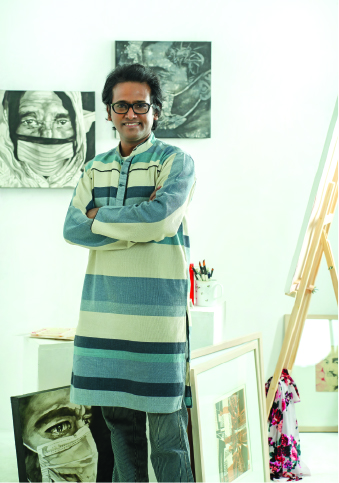RUHUL KARIM RUMEE, ASSISTANT PROFESSOR AT THE INSTITUTE OF FINE ART, UNIVERSITY OF CHITTAGONG, SHARES WORDS OF INSPIRATION FOR ASPIRING ARTISTS AND DETAILS HIS JOURNEY AS AN ARTIST AND AS A TEACHER.

A lot of your works are portraits that invoke a range of emotions in your audience. What gravitates you towards portraits?
To me, a portrait is the viewfinder to our emotions. Every person’s face is a mirror of their mind. Through our facial expressions, particularly, our eyes, we can say so much without speaking a single word. I find that fascinating! When I’m working on a portrait, I can connect with the emotions of my subjects.
Portraits can also make a grand statement when its scale is large. Oftentimes, when I am working on a large project, the portrait transforms to a landscape. Minute details speak out to me and can invoke such feelings, that it starts introducing new layers and dimensions.

Please tell us about your experience teaching as an Assistant Professor at the Institute of Fine Art at the University of Chittagong.
Fine arts classes at the University of Chittagong are practical. We hold classes 5 days a week. On the first day of the week, our students get assignments. On the last day, we sit together in a meeting with the students and talk about their work. Since the courses are academic, most of them focus on the basics such as figure drawing, composition and perspective.
It’s very interesting teaching fine arts classes because they are not traditional in nature. We encourage our students to adopt creative means to fulfil their objectives. It often happens that we ask students to explore nature for inspiration. I believe that a student who can communicate with nature, and find inspiration from the beautiful gifts of this world’s creation, is capable of achieving greatness. Nature is always changing. The sun and its rays, the cloud and the weather – they are all so dynamic, that every single day, it has a new story to tell.
We often hold classes outdoors. We have held classes in rail-stations, where the students were able to witness the diversity of humanity. For an annual study, we held a class at the zoo. Holding classes outdoors allows students to experience a variety of shapes and figures that reinforces the basics that we teach in our classrooms.
How can art, which is so subjective, be graded for assessment? Would that not go against the subjective nature of the discipline?
That is a very good question. What I always tell my students is that during the first few years of academia, it is inevitable that they will be confused because it is so difficult to judge whether their art is right or wrong. The way the curriculum is organised, during the first 2 years the students learn the basics, and in the 3rd year, they start to apply them. By the fourth year, they have enough confidence to start experimenting with them to tell their own stories through their work. A good analogy would be language. During the first three years, the students learn grammar and vocabulary, and in the final year, they write their own stories.
What we look for is individuality, concepts, and content. Of course, this is academic, therefore we have to grade them. To do that, we observe whether the basics such as proportion, scale, the gradient of light and shadows, and whether the aesthetics complement the piece as a whole. After that, we look for the story in their work. While their creativity will push them to break the rules and play with shapes and sizes, what we look for is whether these decisions make for a good story in their work.
OUR ARTISTS ARE SO DYNAMIC, AND THEY HAVE SO MANY STORIES TO TELL THROUGH THEIR WORK. I BELIEVE INSTITUTIONS CAN HOST MORE PROGRAMS AND EXHIBITIONS WHERE THE PEOPLE OF THIS COUNTRY CAN VISIT TO APPRECIATE AND TAKE IN THE CREATIVITY THAT OUR ARTISTS HAVE TO OFFER.
What was your experience like when you were a student?
A common observation among students, which also applied to me back in the day, is that we are, or were, confused. But like any other discipline, practice is essential to overcome uncertainties and hesitations. I was lucky enough to be under the tutelage of amazing artists such as Shishir Bhattacharjee, Sheikh Afzal, Saifuddin Ahmed and Mohammad Kibria. In the art world, they are legends. To me, being able to share my drawings and paintings with them was a privilege. So, the most common emotion among students, fear, is something you have to work through. The more you work, the more you understand the basics. At a certain point, you start seeing a positive response to your hard work, and the fear slowly starts to disappear.
The art culture in Bangladesh is now more alive than ever before. But what more could be done to sustain and enrich this growth?
This is a very difficult question and there are no straightforward answers. I believe there needs to be a collaborative process where several bodies come together to take an initiative. I can speak from my own experience that Bangladesh continues to create fantastic talent. If we are able to recognise that and give them a platform where we may exchange knowledge, culture and information about artwork, then that would be a necessary step forward. Our artists are so dynamic, and they have so many stories to tell through their work. I believe institutions can host more programs and exhibitions where the people of this country can visit to appreciate and take in the creativity that our artists have to offer.
